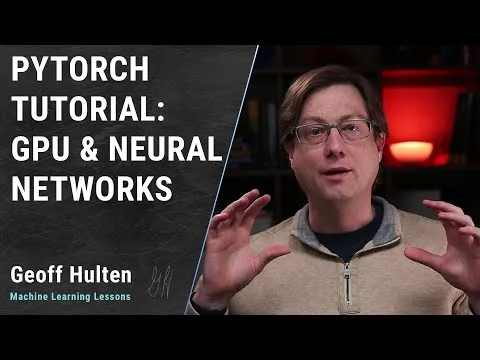
PyTorch Basics for Machine Learning 
This IBM course provides an introduction to the basics of PyTorch, a popular open source machine learning library. Learners who successfully complete the course will earn a skill badge, a digital credential that verifies their knowledge and skills. Enroll now to learn more and gain a valuable credential. ▼
ADVERTISEMENT
Course Feature
![]() Cost:
Cost:
Free
![]() Provider:
Provider:
Edx
![]() Certificate:
Certificate:
Paid Certification
![]() Language:
Language:
English
![]() Start Date:
Start Date:
Self paced
Course Overview
❗The content presented here is sourced directly from Edx platform. For comprehensive course details, including enrollment information, simply click on the 'Go to class' link on our website.
Updated in [February 21st, 2023]
Please Note: Learners who successfully complete this IBM course can earn a skill badge — a detailed, verifiable and digital credential that profiles the knowledge and skills you've acquired in this course. Enroll to learn more, complete the course and claim your badge!
This course is the first part in a two part course and will teach you the fundamentals of Pytorch while providing the necessary prerequisites you need before you build deep learning models.
We will start off with PyTorch's tensors in one dimension and two dimensions , you will learn the tensor types an operations, PyTorchs Automatic Differentiation package and integration with Pandas and Numpy. This is followed by an in-depth overview of the dataset object and transformations; this is the first step in building Pipelines in PyTorch.
In module two we will learn how to train a linear regression model. You will review the fundamentals of training your model including concepts such as loss, cost and gradient descent. You will learn the fundamentals of PyTorch including how to make a prediction using PyTorch's linear class and custom modules. Then determine loss and cost with PyTorch. Finally you will implement gradient descent via first principles.
In module three you will train a linear regression model via PyTorch's build in functionality, developing an understanding of the key components of PyTorch. This will include how to effectively train PyTorch's custom modules using the optimizer object, allowing you an effective way to train any model. We will introduce the data loader allowing you more flexibility when working with massive datasets . You will learn to save your model and training in applications such as cross validation for hyperparameter selection, early stopping and checkpoints.
In module three you will learn how to extend your model to multiple input and output dimensions in applications such as multiple linear regression and multiple output linear regression. You will learn the fundamentals of the linear object, including how it interacts with data with different dimensions and number of samples. Finally you will learn how to train these models in PyTorch.
In module four you will review linear classifiers, logistic regression and the issue of using different loss functions. You will learn how to implement logistic regression in PyTorch several ways, including using custom modules and using the sequential method. You will test your skills in a final project.
(Please note that we obtained the following content based on information that users may want to know, such as skills, applicable scenarios, future development, etc., combined with AI tools, and have been manually reviewed)
What skills and knowledge will you acquire during this course?
By taking this course, learners will acquire a comprehensive understanding of the fundamentals of PyTorch, including tensors, operations, automatic differentiation, and integration with Pandas and Numpy. They will also gain knowledge of how to train a linear regression model, including concepts such as loss, cost, and gradient descent. Additionally, learners will learn how to extend their models to multiple input and output dimensions, as well as how to use linear classifiers, logistic regression, and different loss functions. Finally, learners will be able to apply their skills in a final project and earn a skill badge upon successful completion of the course.
How does this course contribute to professional growth?
This course provides learners with the fundamentals of PyTorch, including tensors, operations, automatic differentiation, and integration with Pandas and Numpy. It also covers topics such as training a linear regression model, extending models to multiple input and output dimensions, using linear classifiers, logistic regression, and different loss functions. Through the final project, learners can apply their skills and gain a skill badge upon successful completion of the course. This course provides learners with the opportunity to gain valuable knowledge and skills in PyTorch, which can contribute to their professional growth.
Is this course suitable for preparing further education?
PyTorch Basics for Machine Learning is a suitable course for preparing further education. It covers the fundamentals of PyTorch, including tensors, operations, automatic differentiation, and integration with Pandas and Numpy. Learners can also learn how to train a linear regression model, including concepts such as loss, cost, and gradient descent. Additionally, learners can learn how to extend their models to multiple input and output dimensions, as well as how to use linear classifiers, logistic regression, and different loss functions. Finally, learners can apply their skills in a final project and earn a skill badge upon successful completion of the course. This course provides a comprehensive introduction to the fundamentals of PyTorch and provides learners with the necessary skills to pursue further education in the field.
Course Provider

Provider Edx's Stats at AZClass
Discussion and Reviews
0.0 (Based on 0 reviews)
Explore Similar Online Courses

Make the Sale: Build Launch and Manage E-commerce Stores

Computer Vision and Image Processing Fundamentals

Python for Informatics: Exploring Information

Social Network Analysis

Introduction to Systematic Review and Meta-Analysis

The Analytics Edge

DCO042 - Python For Informatics

Causal Diagrams: Draw Your Assumptions Before Your Conclusions

Whole genome sequencing of bacterial genomes - tools and applications

PyTorch Tutorial - Neural Networks & GPU

Applied Deep Learning with PyTorch - Full Course

Intro to Deep Learning with PyTorch
 Related Categories
Related Categories
 Popular Providers
Popular Providers
Quiz
 Submitted Sucessfully
Submitted Sucessfully
1. What is the first step in building Pipelines in PyTorch?
2. What is the purpose of the data loader?
3. What is the purpose of the optimizer object?
4. What is the final project in this course?


Start your review of PyTorch Basics for Machine Learning